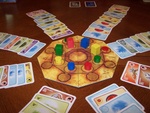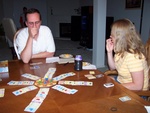
|
Fredericus A game by Eligio Cazzato Published by da Vinci Games and distributed by Mayfair Games, Inc. Players: 2-4 Time: 30-45 minutes Reviewed by Susan Rozmiarek |

|
Fredericus takes place in the Kingdom of Sicily in the year 1246. The Emperor's fortress is under attack by mythological creatures and the players are falconers using their falcons to capture the creatures for study.
Components:
Fredericus comes in a small box that contains the following:
- A small, octagonal game board representing the fortress. There is a courtyard in the center and each side had a two spots representing a tower and a keep.
- Wooden tokens - A peregrine falcon token, a goshawk falcon token and a betting token in each of four player colors
- 118 small cards, including:
- 8 emperor's seals
- 24 woods
- 24 skies
- 4 each of 8 different mythological creatures
- 24 secret goal cards - 3 of each of the 8 creatures
- 4 falconers
- 1 Fredericus
- 1 starting player card
- A black and white rulebook with rules in five languages. The rules are fairly well-written with clear, illustrated examples.
Game play:
Turns are taken in a clockwise order starting with the first player. Players will be trying to capture creatures and goal cards on their turn. They must take exactly four actions from the following list on each of their turns. The actions can be done is any order and they can be multiples of the same action. A player does not have to perform all the types of actions on his turn.
- Move one card from the end of a row to the end of an adjacent row. This is the puzzle-like part of the game and the one that appealed to me the most. You are trying to move the cards in such a way as to set up a situation where one or both of your falcons can capture a creature at the end of your turn. (Described below).
- Move one of your falcons from one tower to an adjacent tower. There is no limit to the number of falcons that can be on a single tower.
- Hood an opponent's falcon. This can be done to any opponent falcons that are sitting on a tower that has a woods card showing at the end of both adjacent rows. The only caveat is that both falcons of a single player cannot be hooded. This is the "take that" part of the game. It's often chosen when a player has no other beneficial actions to take. Hooded falcons are out of the action and unable to move or hunt during their owner's next turn. The owner gets to remove the hood at the end of his turn. However, since he is unable to move the falcon away from the setup that allowed it to be hooded, he might have to spend precious actions to change the setup or another player is likely to hood it again. This was an annoying aspect of the game that I didn't like as it was very frustrating to be a player caught in this cycle.
The player may also do the following actions at any time during his turn if he is able. Neither of these counts as one of his four actions:
- Capture one or two creatures. If a player's peregrine falcon is on a tower with a creature at the end of its row and the cards at the end of both adjacent rows are sky cards, the player captures the creature and places the card face-up in front of him. For the goshawk falcon to capture a creature in the same way, the card at the end of one adjacent row must be a sky card and the card at the end of the other adjacent row must be a woods card. Each falcon may only capture one creature per turn.
- Open the emperor's seals. If you have at least one of your falcons on a tower that has an emperor's seal card at the end of both adjacent rows, you can then reverse the order of cards in the row in front of the tower with your falcon. You also get to draw the top goal card and you must then discard one of the emperor's seals used. This was a rather bizarre mechanism to me; I didn't understand how it fit into the theme at all. I suppose one of its functions in the game is to prevent rows from stagnating with the creatures in it buried, but with the limited number of seals, this action didn't happen often in the games that I played.
- Sets his hooded falcon free if he has one.
- Place his betting token on any keep. If, on his turn, another player captures a creature from the tower within the keep that has your betting token on it, you get to draw a goal card. You then get your token back to place on your next turn. With three or four players, another option is to place your token in the center of the board. If no creatures have been captured when it is again your turn, you draw a goal card.
The game ends when the Fredericus card is drawn from the goal deck and the round is finished or when one player captures eight creatures. Driving the game along is a rather nice mechanism. The last player in the turn order manages the goal deck. At the end of each of his turns, he turns the top goal card over and discards it face-up. This keeps the game down to a reasonable length for me, although some players felt the game was over too quickly.
Now players score their creature and goal cards:
- Each creature and goal card is worth 1 point.
- Fredericus is 2 points
- Pairs consisting of one creature card and its matching goal card are awarded 1 point for the first pair, 2 for the second, three for the third and so on.
Conclusion:
I really liked the clever, puzzle-like play of manipulating the rows of cards in this game. The theme is unique, albeit a bit strange, and with the exception of the emperor's seal fits the game play fairly well. That being said, there are number of things about it that I didn't care for that forces me to put it into the mediocre category. The thing that bothers me the most is the scoring. The drawing of goal cards is entirely random yet is a significant portion of a player's score. In theory, I guess you should be trying to capture creatures that match the goal cards that you have already collected. In reality though, you usually don't have that much choice and you go after any creature that you can. The winners of our game were those lucky enough to draw matching goal cards. This large element of luck clashed with the clever play needed to capture creatures.
The placing of bets, as I mentioned earlier, only worked with certain groups of players. With stingy players, this is not a good way to get goal cards and the game felt less satisfying. If the emperor's seals were buried in rows as well, then it is even more difficult to acquire goal cards.
Overall, Fredericus is not a bad game, but I feel it could have been even better if a few things were tweaked somehow. It is simple and easy to teach and has an original feel despite its flaws. I certainly wouldn't refuse to play it, but it's not one I'd request.
| Other Web information: |
This page viewed
E-mail Ed Rozmiarek with questions or problems concerning this page.
Copyright © 2005, Ed & Susan Rozmiarek. No portion of this website may be reproduced or copied without the consent of Ed or Susan Rozmiarek.



